Top US Catering Management Software: Transforming the Industry
 18 January 2024
18 January 2024? Listen to the Summary of this article in Audio
The United States has seen a significant surge in the adoption of catering management software, reshaping the capabilities and efficiency of the hospitality sector. Esteemed names such as Amadeus Sales & Event Management, Caterease, and FoodStorm are at the forefront, providing robust online catering software solutions that encompass every facet of catering operations. These platforms have been diligently crafted to address the comprehensive demands of the catering industry, enabling businesses to flawlessly manage schedules, orders, and customer relations in a unified system.
This evolution in catering management platform development is a testament to the innovative strides taken to enhance the intricate processes of the catering industry software market. With each software not just facilitating booking and order management but also incorporating advanced tools for marketing and customer engagement, catering professionals can now deliver exceptional service aligned with the dynamic needs of their clientele.
Key Takeaways
- Innovative catering management software development is revolutionizing the hospitality industry in the U.S.
- Comprehensive online catering software simplifies operations, from inventory to customer communications.
- Top-tier catering management platforms are equipped with features for enhanced customer experience and operational efficiency.
- Emergence of catering industry software has led to automated, sophisticated management of catering tasks
- Businesses now have access to data-driven insights and integrated marketing tools within their catering software solutions.
Understanding the Rise of Catering Management Software
The catering industry has embraced a remarkable digital transformation, driven by the prospect of catering software development fulfilling the intricate requirements of modern-day events. The evolution from fundamental tools to comprehensive catering software solutions signifies a leap towards operational efficiency that has resonated throughout the food and hospitality sectors.

Evolution of Digital Solutions in Catering
Historically considered a secondary support tool, catering technology has now become central to managing hectic kitchen workflows and delivering exceptional guest experiences. What began as simple scheduling and booking software has now advanced to include real-time inventory management and multi-channel communication gateways, ensuring smooth orchestration behind the scenes.
The transition of digital solutions in the catering realm can be primarily attributed to the industry’s need for software that bridges the gap between customer preferences and back-end efficiency. The inclusion of project and workforce management within these platforms aims to synergize the efforts of various departments, from kitchen prep to front-of-house operations.
Benefits of Transitioning to Software Solutions
Software for catering businesses has come to the forefront as the linchpin for growth and customer satisfaction. Automation in inventory and staff scheduling saves precious time, while intuitive user interfaces streamline the learning curve for new staff members. Enhanced communication tools have been pivotal in fostering transparent and timely interactions with clients, directly translating to increased trust and loyalty.
- Automation of administrative tasks reduces manual errors and improves efficiency.
- Integrated customer relationship management tools strengthen client relations.
- Analytics and reporting provide actionable insights for strategic planning.
- Marketing automation drives customer engagement and promotes brand awareness.
Amidst countless benefits of catering management systems, perhaps the most visible impact is on a business’s bottom line. The cumulative effect of saving time, reducing costs, and driving sales with effective marketing is an opportunity that caterers can hardly afford to ignore.
“Catering software has the power not just to manage but to amplify our services, creating events that leave lasting impressions.”
The advantages of adopting a digital approach extend beyond logistical management. Featuring comprehensive reports, these systems offer a diagnosic view of sales trends and staff productivity, reinforcing the notion that informed decision-making is crucial for success.
| Feature | Impact on Catering Business |
|---|---|
| Real-time Inventory Management | Decreases wastage and ensures readiness for upcoming events |
| Automated Staff Scheduling | Optimizes workforce allocation, reducing labor costs |
| CRM Integration | Enhances customer engagement and loyalty through personalized communication |
| Analytics and Reporting | Enables strategic decision-making based on accurate data |
| Marketing Automation | Extends the reach of campaigns and simplifies customer acquisition |
As the catering sector continues to innovate, the role of a catering software solution as the central nervous system of a catering business is undeniable. The benefits of ushering in a new era of digital efficiency are manifold, positioning catering businesses well ahead of the traditional curve and paving the way for a data-driven, customer-centric future.
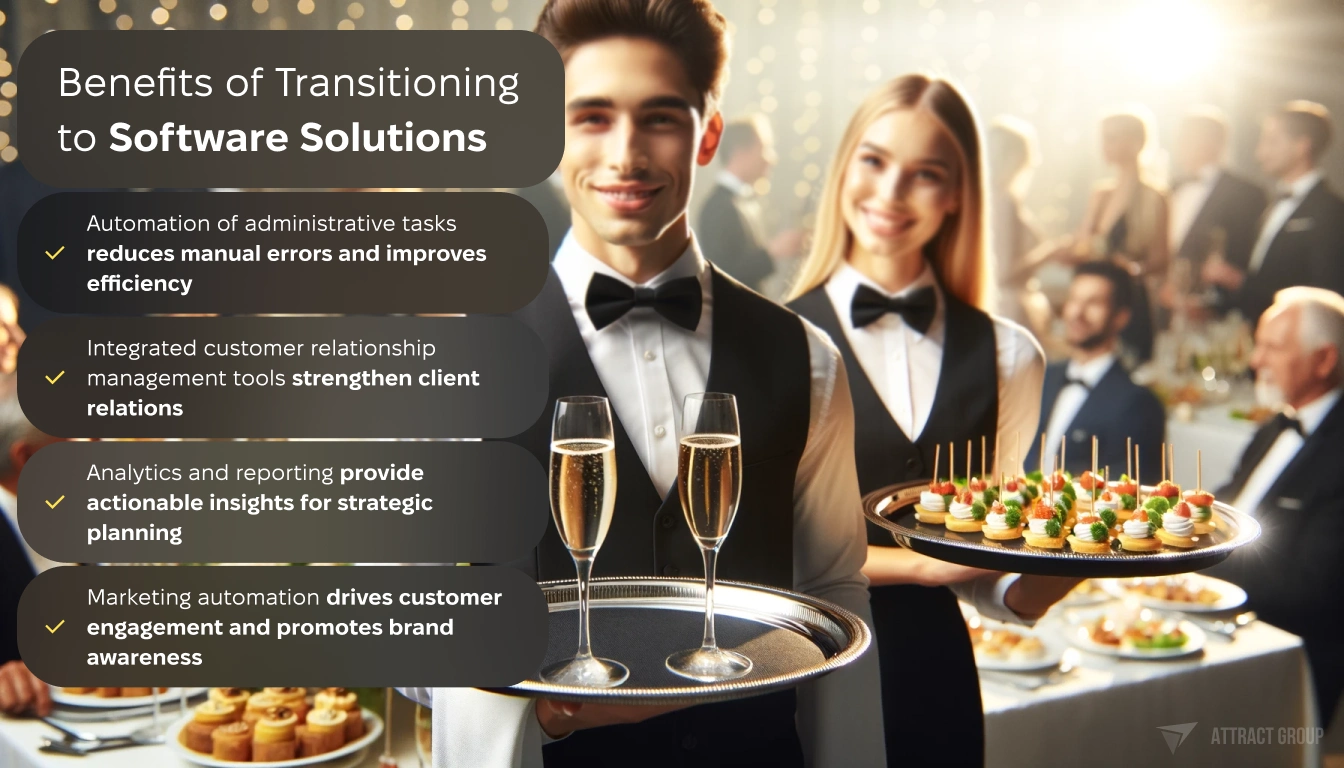
Our experts can develop tailored catering management software aligned to your business’ unique processes and requirements.
Key Features of Top Catering Management Systems
Within the competitive landscape of catering operations, the adoption of a highly functional catering management system stands as a transformative decision. The best systems in the market come equipped with a set of catering software features that cater to the full spectrum of catering needs — from optimizing staff schedules to comprehensive customer relationship management. The following table encapsulates the key features that top-tier catering management systems offer, alongside the benefits they deliver to the businesses that implement them.
| Features | Description | Benefits |
|---|---|---|
| Staff Scheduling | Automated system for managing staff assignments and shift patterns. | Increases operational efficiency and reduces the potential for scheduling conflicts. |
| Inventory Management | Tools to track ingredient usage and predict future needs. | Minimizes waste, controls costs, and facilitates event planning. |
| Project & Event Management | Centralized dashboard to monitor all aspects of event execution. | Ensures successful and smooth event operations, from setup to breakdown. |
| Online Booking & Order Management | Portal for clients to schedule events and manage orders remotely. | Improves customer convenience and streamlines order intake. |
| Invoicing & Payment Processing | Integrated system for billing clients and managing transactions. | Facilitates quicker payments and reduces administrative overhead. |
| Delivery Route Optimization | Tools to plan the most efficient delivery paths for events. | Saves time and fuel costs, leading to more on-time deliveries. |
| Customer Relationship Management (CRM) | Features that manage customer data, interactions, and history. | Enhances customer loyalty and enables targeted marketing efforts. |
| Mobile Optimization | Responsive design that adapts to various mobile devices. | Allows staff to access the system from anywhere, improving reaction time to customer needs. |
| Marketing Capabilities | Email, SMS, and social media tools integrated into the system. | Expands brand reach and engages the customer base effectively. |
The diverse needs and operational scopes of catering businesses, from boutique firms to expansive hospitality enterprises, dictate the necessity for versatile software solutions. Whether a business favors a cloud-based or on-premise deployment, catering management systems can often be tailored to fit. These features are not just amenities but critical components that streamline operations, drive efficiency, and bolster customer engagement within the dynamic field of catering services.
“Choosing the right catering management system with the appropriate features is not just an investment in technology — it’s an investment in the future of your business.”
Ultimately, the commitment to adopting one of these advanced systems is a strategic move. By integrating comprehensively designed features into their workflows, catering service providers can transform the client experience, amplify their brand’s impact, and navigate operations with newfound agility and insight.
How Custom Software Development Elevates Catering Services
The dynamics of catering services have been significantly transformed by advances in custom catering management software development. These technological innovations allow businesses to serve up quality and efficiency on a silver platter — metaphorically speaking — through tailored catering software solutions that cater to the unique operations of their establishment.

The Importance of Tailored Solutions
Every catering business comes with its distinctive challenges and requirements, which off-the-shelf software often fails to address comprehensively. This is where specific software solutions for catering businesses come into play. Personalized software caters to the distinct flavors of an establishment’s operational needs, offering functionalities that sync perfectly with their business model and growth trajectory.
“Custom software is like a master chef’s unique recipe, it brings out the best flavors of your catering business by adding just the right ingredients and techniques tailored for your success.”
Solutions crafted through custom catering management software development not only streamline operations but also embellish the guest experience, setting the table for return business and a robust reputation in the highly competitive hospitality landscape.
Integrating Specific Business Needs
The difference between satisfactory and exceptional service can hinge on the subtleties of software functionalities. Requirements such as creating customized menu templates, specific workflows for managing distinct types of events, and seamless integration with existing systems are pillars upon which superior catering services are built.
- Customized menu templates accommodate the diverse tastes and dietary restrictions of clients.
- Workflows tailored for different events ensure consistency and precision in execution.
- Integration with existing systems fosters a unified ecosystem for all business operations.
With a focus on scalability for operations that span multiple locations, adherence to rigorous hospitality standards, and the leverage of analytics for informed decision-making, custom software development is the key ingredient in the recipe for a successful catering business. Such a strategic approach enables businesses to respond agilely to market demands while maintaining utmost quality and customer satisfaction.
| Business Need | Software Solution | Operational Benefit |
|---|---|---|
| Customized Menu Creation | Software with bespoke menu design features | Menus tailored to the event, enhancing client satisfaction |
| Multi-Event Management | Event-specific workflow integration | Seamless management of varying event types, improving service delivery |
| Multi-Branch Scalability | Customizable cross-branch management tools | Efficient operations across different locations, boosting productivity |
| Comprehensive Analytics | Advanced data analysis modules | Data-driven decision-making, propelling business growth |
| System Integration | Compatibility with existing hardware and software | Unified operations, reducing complexity |
Specific software solutions for catering businesses are not just about customization — they’re about creating a specialized experience that resonates with both the clientele and the operational teams. By harnessing the power of tailored software, catering businesses can ensure their services are always executed with precision, passion, and a touch of personalization that leaves a lasting impression on guests.
Connect your catering software with existing tools for efficient information flow across all systems.
Comparing Cloud-Based vs On-Premise Catering Software
The evolution of catering management has been marked by significant tech developments, particularly in choosing between cloud-based catering software and on-premise catering management systems. Each serves a critical role in catering operations, but their functionalities diverge to meet differing business needs. Understanding the nuances between these two can empower catering businesses to make informed decisions that align with their operating model and strategic goals.
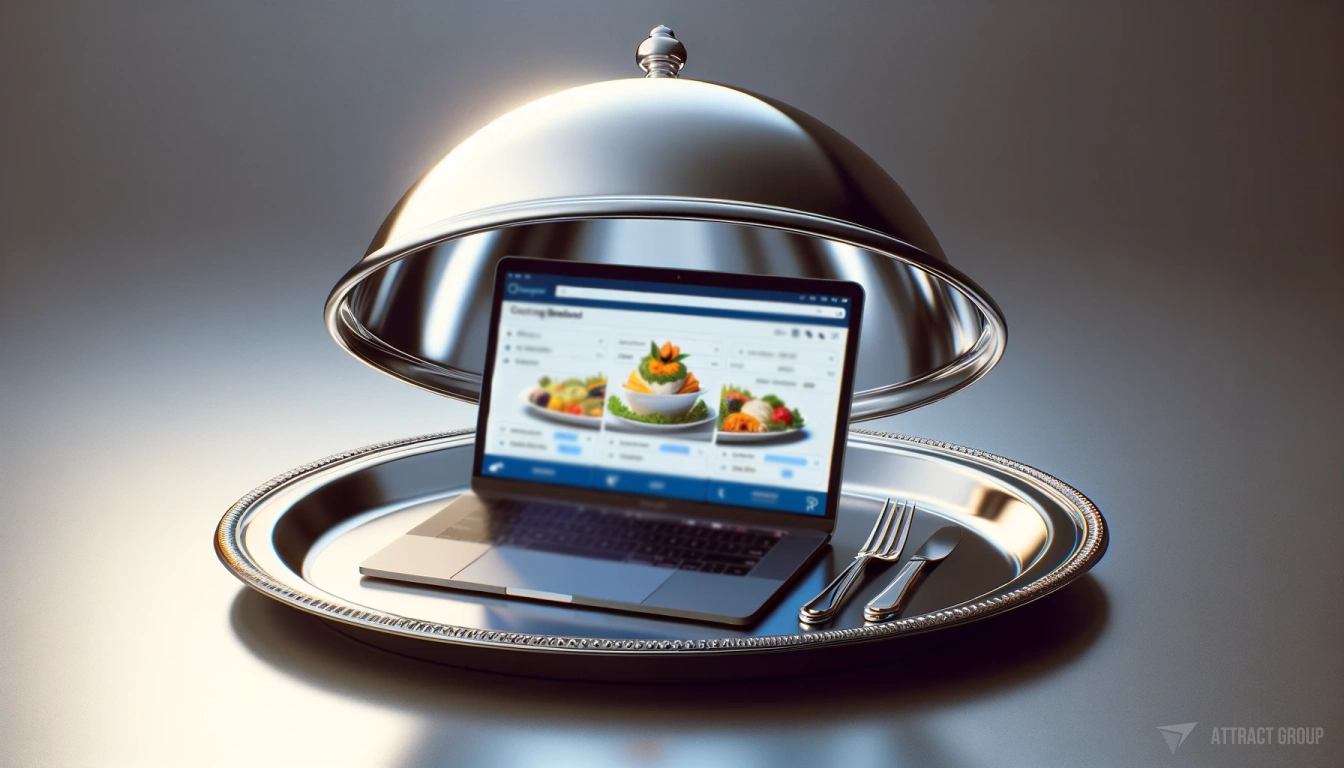
Accessibility, security, and customization are pivotal factors driving the decision on whether to deploy a cloud-based solution or to maintain an on-premise infrastructure. Below, we delve into the core differences between these two options and how they can potentially impact the day-to-day operations of a catering company.
| Aspect | Cloud-Based Catering Software | On-Premise Catering Management System |
|---|---|---|
| Accessibility | Accessible from any device with internet connectivity; typically comes with mobile app support. | Localized to specific on-site machines; requires direct access to the business’s server. |
| Data Security | Depends on the provider’s security measures; data stored off-site. | Business controls its own data security; data stored on-site with potentially enhanced control. |
| Cost | Usually a subscription model, often with lower initial costs but recurring payments. | May involve higher upfront investment for infrastructure, but potentially lower long-term costs. |
| Customization | Often includes customizable features, but within the constraints of the cloud platform. | Allows for extensive customization to meet specific business needs. |
| Software Updates | Automatic updates provided by the software vendor; minimal IT effort required. | Updates controlled by the business; IT team responsible for implementation. |
| Scalability | Easily scalable to accommodate business growth, typically without significant infrastructure changes. | Scaling up may require additional onsite hardware or software licenses. |
From a flexibility standpoint, cloud-based catering software has reshaped the landscape, liberating catering professionals from the confines of traditional office spaces. This mobility encourages real-time responses to client demands and operational needs. On the contrary, an on-premise catering management system ensures that data remains within the controlled environment of the company’s premises, which might be preferable for organizations with demanding data security requirements or those needing intricate customizations.
“A caterer’s choice between cloud-based and on-premise solutions directly influences their capability to adapt, grow, and secure their business operations.”
The comparative analysis presented here sheds light on the essential characteristics of each software deployment type. As technology continues to evolve and the catering industry grows more competitive, the benefits and trade-offs of cloud and on-premise systems will continue to influence business operations and strategic direction in the world of catering management.
Optimizing Operations with Online Catering Software Tools
Embracing online catering software tools is no longer optional for catering companies striving to refine their operations and strengthen customer loyalty. These digital advancements are poised to redefine productivity benchmarks by honing the precision of the catering booking process optimization. The ensuing synergy of technology and service not only elevates the client experience but also injects notable vigor into the operational tempo of caterers.
Streamlining the Booking Process
In the quest for amplifying catering business efficiency, the fundamental step lies in refining the reservation interface. This is where cutting-edge catering software steps in, simplifying the booking trajectory from start to finish. The software’s ability to collate initial estimates, seamlessly navigate through changes, and adeptly handle essential client information, defines a new echelon of customer service efficiency.
- Instantaneous updates and revisions for event estimates
- Comprehensive client data management
- Foolproof scheduling accuracy to avoid double bookings
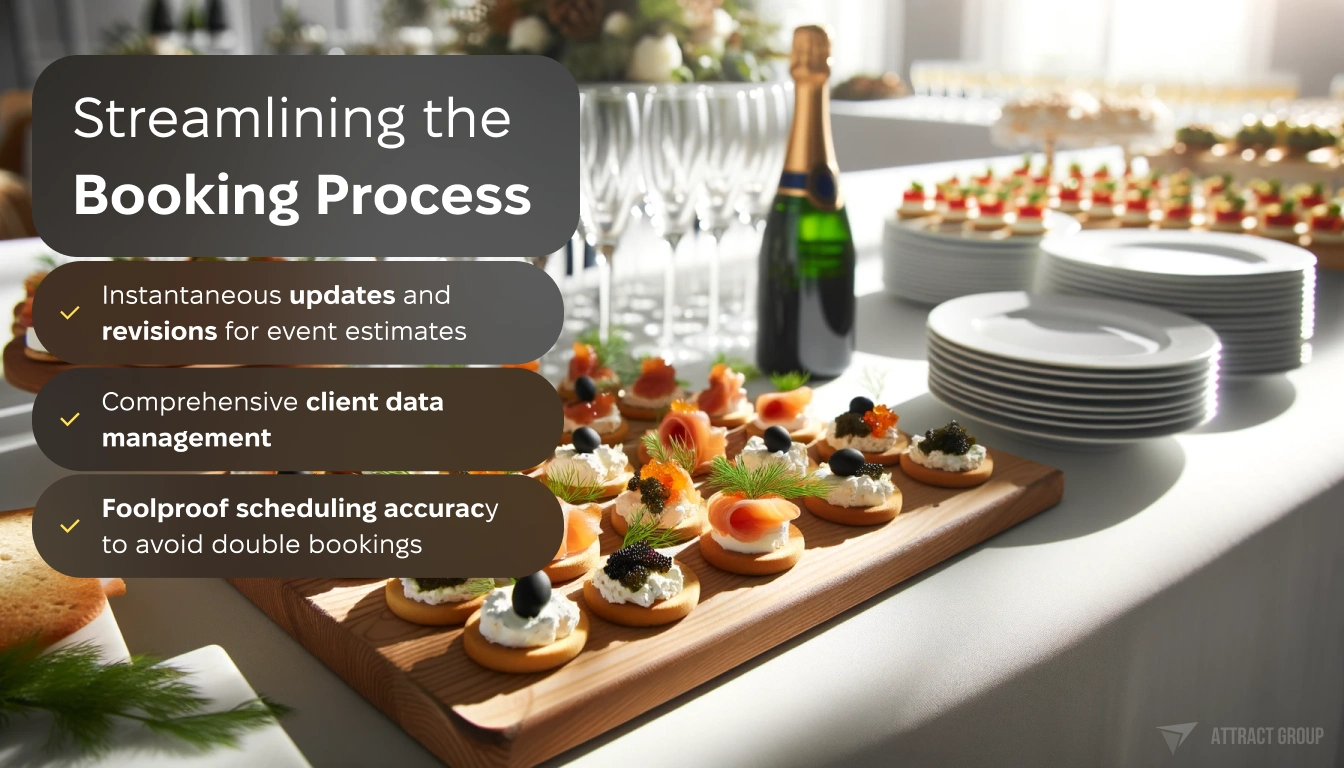
Enhancing Customer Experience through Technology
Central to enhancing customer experience is the intuitive nature of interactive menus and a more inclusive event planning process facilitated by catering technology. Compelling visual design features and responsive client interfaces within these tools offer a cohesive system to manage events and venues, assuring the delivery of unparalleled service quality.
Implementing online catering software is tantamount to setting a digital stage where every actor in the event saga plays their role with harmonious timing and finesse.
- Visual, drag-and-drop menu planners for immediate client feedback
- Dynamic venue scheduling that keeps all parties informed
- Real-time communication channels for prompt customer engagement
Driving Efficiency with Automated Features
The transformative magic wand in the realm of catering software automation is the array of features designed to compress the time invested in administering catering functions. By relegating manual processes to automation, these tools substantially diminish the incidence of error while concurrently accelerating tasks such as billing, payment tracking, and logistical coordination.
| Feature | Function | Benefit |
|---|---|---|
| Automated Invoicing | Generates and dispatches invoices with precision and speed | Slashes administrative labor and expedites payment cycle |
| Payment Tracking | Monitors transactions in real-time with alerts | Provides accurate financial reporting and reduces oversight |
| Delivery Scheduling | Automates delivery timelines and optimizes routes | Guarantees outstanding punctuality and cost management |
| Rental Agreement Management | Systemizes rental contract creation and execution | Streamlines asset utilization and aids in event execution |
By instilling a culture of technological embracement, catering businesses do more than just keep pace; they catapult themselves to the vanguard of operational excellence. The catering software automation capabilities become an indispensable mechanism, propelling services towards a future where precision, efficiency, and client satisfaction are interwoven into the very fabric of a thriving catering enterprise.
Let our experts guide you in selecting the best deployment model for your catering business needs.
The Impact of Mobile Optimization on Catering Software
As the events industry continues to evolve, the demand for mobile optimization catering software significantly escalates. This adaptation is largely driven by the necessity for swift, on-the-move business management. Particularly in the catering sector, where responsiveness can make or break customer relationships, the ability to perform tasks effortlessly on mobile devices is no longer just advantageous—it’s essential.
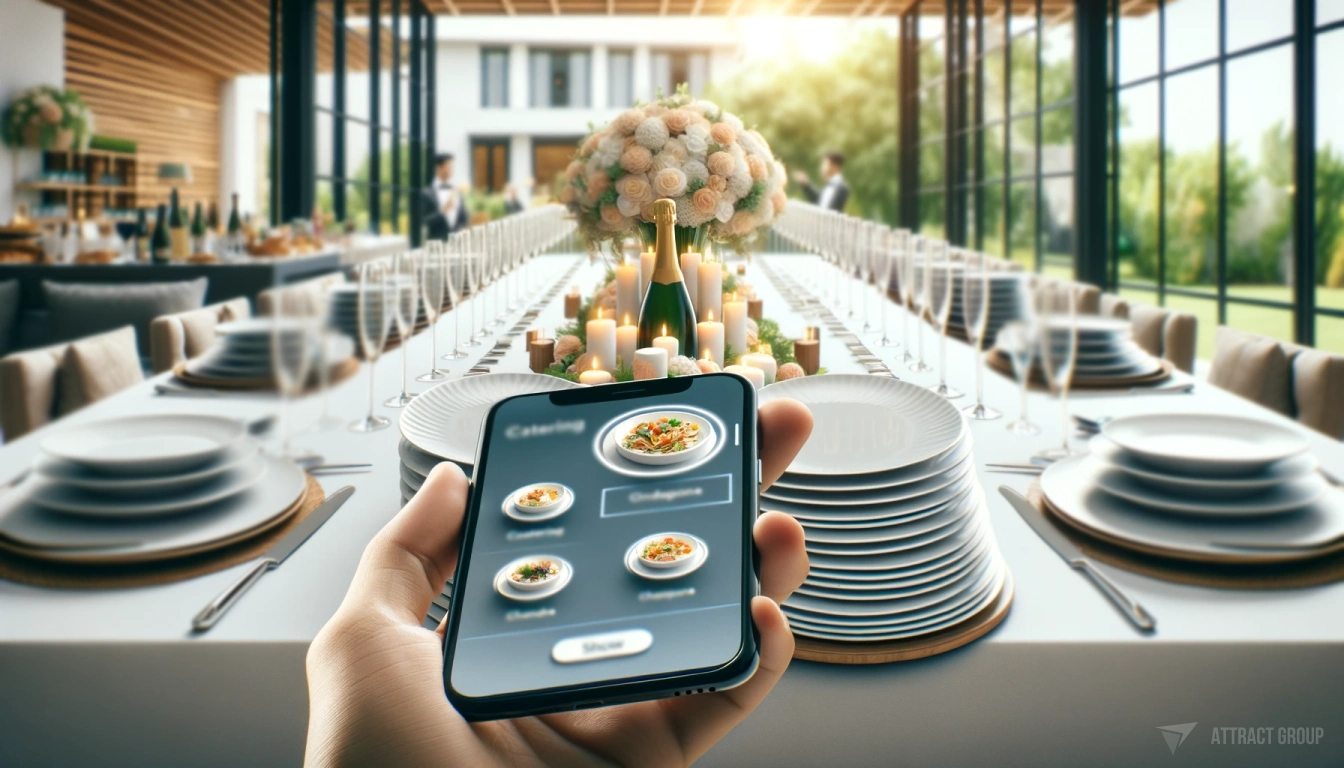
Utilizing responsive catering management software empowers catering professionals to manage their operations with unmatched convenience and agility. With user interfaces specifically designed for optimum functionality on various screen sizes, these mobile-optimized solutions assure comprehensive accessibility, whether on smartphones, tablets, or other devices.
The surge in remote work trends has catalyzed the adoption of mobile catering solutions, setting new standards for operational fluidity and customer service excellence.
- Real-time event and order updates are merely a tap away, ensuring immediate action and clarity in communications.
- Meticulously designed menus, event plans, and invoices can be perused and approved on-the-go, accelerating workflow progress.
- Location-based services augment delivery systems and improve onsite event management, elevating the client experience.
Responsive interfaces also enhance client interactions, as accessibility fosters an environment where swift, informed decisions are the norm, not the exception. This quickness in communication stands as a paramount aspect of successful client servicing in today’s fast-paced, tech-savvy marketplace.
| Mobile Feature | Operational Benefit | Client Servicing Enhancement |
|---|---|---|
| Real-time Alerting System | Instant notification on updates and changes ensures an ever-ready state for any contingencies. | Builds assurance and reliability amongst clients with prompt resolutions and updates. |
| On-Demand Reporting | Managers can pull up sales and performance data anywhere, fostering informed decision-making. | Transparency with clients on event success metrics nurtures trust and future collaborations. |
| User-Friendly Dashboard | Data visualization and easy navigation bolster operational control and overview. | Clients receive a clearer, more understandable breakdown of services and costs. |
| Multi-Device Syncing | Cross-device compatibility ensures seamless transition from desktop to mobile workflows. | Enhances clients’ ability to interact with the services on their preferred devices. |
Сatering businesses that prioritize mobile optimization in their software not only set the stage for internal operational prowess but also hone the edge they have in the indulgence-driven market of event catering. As more catering managers and staff adopt these responsive platforms, a new horizon for excellence and client satisfaction emerges, underpinned by the versatile, on-demand nature of mobile catering solutions.
Integrating Payment Processing Into Catering Management Platforms
The integration of in-software payment processing systems into catering management platforms is a groundbreaking development within the event planning and hospitality industry. This seamless fusion of financial transaction capabilities within the centralized software enhances the scope of catering payment solutions, providing an inclusive environment for financial management that caters to both providers and clients.
The Convenience of In-Software Payments
By embedding in-software payment processing within the catering software ecosystem, service providers have unlocked new levels of operational efficiency. This method not only enhances the customer journey by providing a streamlined payment experience but also offers profound benefits for catering businesses with regards to financial tracking and cash flow management.
Let’s explore how catering companies can leverage in-software payment processing to refine their financial operations:
“Integrated in-software payment processing within catering management platforms is not merely an added feature, it’s a transformative tool for business optimization and enhanced customer experience.”
- Centralized Transactions: All payment-related activities are consolidated onto one platform, eliminating the need to use separate systems for payment processing and management.
- Automated Invoicing: Invoices are generated directly from within the software, ensuring that the payment requests to clients are timely and consistent with the services rendered.
- Instant Payment Confirmation: Payments can be confirmed in real-time, streamlining accounting processes and swiftly securing revenue.
- Secure Payment Gateway: Integrating reputable payment processors provides a trustworthy and secure environment for all financial transactions.
Offering a comprehensive payment solution integrated into the heart of a catering management system greatly benefits both the provider and the end-user. Below is a concise comparison highlighting the transformation achieved by integrating in-software payment processing into catering management platforms:
| Before Integration | After Integration |
|---|---|
| Use of multiple software solutions for management and payment processing | Unified platform for both management and payment processing |
| Manual payment tracking and reconciliation prone to errors | Automated tracking and reconciliation, reducing errors and administrative burden |
| Delayed payment confirmations impacting cash flow | Immediate payment confirmations enhancing cash flow management |
| Possibility of insecure payment practices compromising client data | Incorporated secure payment practices ensure the protection of client data |
| Extended time spent on financial reporting and analysis | Streamlined financial reporting and analysis due to integrated payment data |
Incorporating in-software payment processing into catering management platforms is more than a leap towards technical sophistication; it’s a commitment to simplifying transactions and enhancing the overall satisfaction of clients. With diverse catering payment solutions now a part of these platforms, businesses can enjoy the perks of safety, convenience, and efficiency that come with technological synergy.
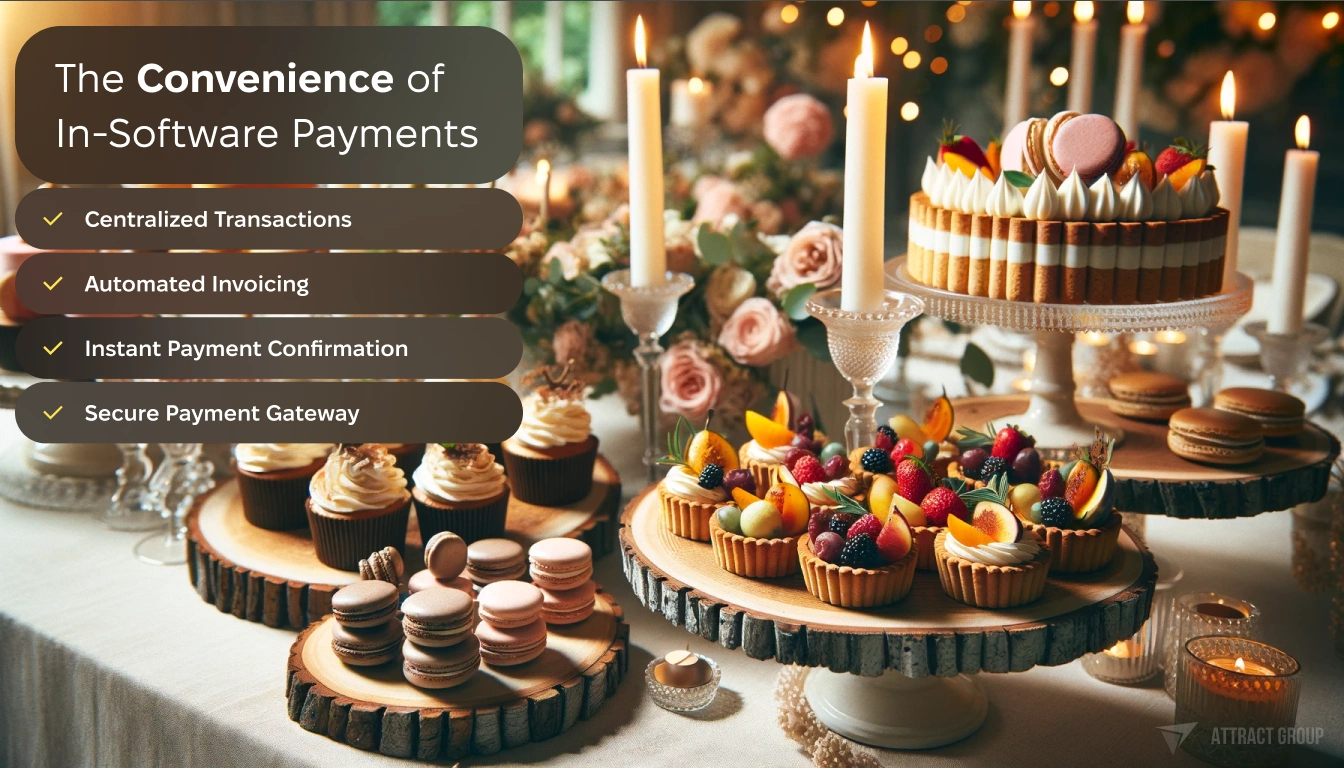
User Experience: A Critical Component in Catering Software Design
The imperative for catering software user experience (UX) is clear as the industry acknowledges its influence on user satisfaction and operational efficacy. The design principles of a successful UX design catering platform hinge on providing a combination of user-friendly interface, straightforward navigation, and potent features that dovetail neatly with day-to-day catering duties. It’s about crafting a digital environment that allows users to harness the tool’s full potential with minimal friction, positively affecting business processes and client engagements.
At the heart of UX is the commitment to crafting an experience that resonates with end-users – catering professionals who demand speed, efficiency, and reliability. Let’s delve into the specifics that make UX an indispensable element of successful catering software.
“User experience in catering software is not just about the look and feel; it’s about creating an intuitive pathway for caterers to orchestrate events with precision and ease.”
Essentials of User-Centric Catering Software
- Intuitive User Interfaces: Clean and uncluttered screens streamline daily operations, reducing task completion times.
- Structured Navigation: Logical flow through the software’s features minimizes learning curves and user frustration.
- Responsive Design: Ensuring usability across various devices including tablets and smartphones.
- Accessible Features: Placing crucial tools at the user’s fingertips to facilitate quick actions and decisions.
When debating between various catering platforms, one should weigh the sophistication of the UX. A superbly designed interface can be the fulcrum on which the efficiency and success of a business pivot.
Consider a billing feature within the software: should it be a labyrinth of clicks or a direct manoeuvre completed within moments? This simplicity and directness are central to a robust UX philosophy in catering software. An exceptional level of UX design ushers in productivity hikes while minimizing the opportunity for human error – a dual benefit that substantially raises the professional caterer’s game.
A deeper dive into the UX design of these platforms uncovers the fine balance between comprehensive features and oversimplification. Catering software must be equipped with the capability to handle complex event intricacies yet presented in a manner that is approachable and manageable for users of varying tech competencies.
Data retrieval and input, two common tasks within catering operations, benefit markedly from a thoughtful UX design. Teams become more adept at leveraging software insights with careful placement and visualization of data within the platform, feeding into a cyclical improvement of both the UX and the catering service itself.
The following table illustrates the benefits of various UX elements in catering software:
| UX Element | Functionality | Business Benefit |
|---|---|---|
| User-Friendly Dashboard | Centralized control panel for instant access to various features | Improves task flow and reduces time on system navigation |
| Interactive Calendars | Visual representation of bookings and timelines | Allows precise scheduling and avoids double-booking scenarios |
| Customizable Templates | Pre-designed yet modifiable templates for menus and invoices | Speeds up document creation while allowing brand personalization |
| Seamless Integrations | Compatibility with other apps for extended functionality | Enables a cohesive ecosystem reducing the need for multiple software solutions |
| Drag-and-Drop Features | Simplifies complex actions into simple interactive tasks | Reduces complexity of event planning and menu configurations |
The paradigm of catering software user experience is ever-evolving, nudged forward by the demands for increased proficiency and polished service delivery. As catering operations continue to become more technology-driven, the centrality of UX in catering software design remains undiminished, dictating the flow and success of countless events across the globe.
Assessing the Best Catering Software Providers in the U.S. Market
Identifying the best catering software providers in the U.S. market is a process that hinges on robust evaluation criteria, including consideration of user feedback, functionality, customizability, and value. In today’s rapidly evolving catering industry, software systems like CaterZen have distinguished themselves by offering comprehensive service tiers to cater to the diverse needs of the sector. Their extensive feature list positions them prominently among the top catering management systems available.
CaterZen and Other Top Performers
As we delve into the array of software available to catering businesses, a few platforms have consistently risen to the top, each known for their unique contributions and specialized services. Let’s take a closer look at these market leaders and what makes them stand out.
“Choosing the right software is crucial in managing the multifaceted nuances of catering operations, fueling growth and enhancing service delivery.”
| Software Provider | Key Features | Target Users | Pricing Model |
|---|---|---|---|
| CaterZen | Customizable menus, delivery routing, marketing tools | Small to large scale catering businesses | Subscription-based with multiple service tiers |
| Toast | POS integration, event management, billing | Restaurants with catering services | Custom-quoted |
| Tripleseat | Venue management, lead tracking, client portal | Event venues and large caterers | Custom-quoted based on features and scale |
Each of these catering management systems caters to specific segments of the industry, reflecting the vastness of catering operations from small businesses to nationwide chains. For example, Toast surfaces as an ideal solution for restaurateurs who wish to harness their POS systems to manage catering orders, completely integrating front-of-house and event operations. Tripleseat provides comprehensive venue and event management features that are catered towards sizable events and venues demanding robust oversight capabilities.
However, CaterZen truly steps up to the plate by delivering an all-encompassing platform that is well-rounded for any size operation. The inclusion of advanced marketing tools within its software suite also aids businesses in effectively promoting their services, thereby potentially increasing their market reach.
The final decision in selecting the best software for any given catering business boils down to nuanced factors such as the scale of operations, specific business needs, and budget constraints. Evaluating these can often be an overwhelming task for caterers who must also balance day-to-day service excellence. Thus, the market acknowledges the variance in requirements, offering tailored solutions to remedy the administrative challenges faced by caterers.
“Adaptation and integration of suitable software solutions is not just an upgrade, it’s a strategic step towards operational and service excellence in catering.”
Ultimately, the best catering software providers understand the complexity of their clients’ operations and provide a product that is not just a tool but a partner in the pursuit of culinary excellence and customer satisfaction. CaterZen, with its refined approach to catering management, emerges as a leader, providing the versatility and depth required to navigate and thrive in the U.S. catering market.

Conclusion
The landscape of the hospitality industry within the United States has been irrevocably enhanced by the advent of advanced catering management software, marking a turning point for efficiency and customer engagement in catering services. This innovation offers comprehensive, customizable catering software solutions, which respond adeptly to the intricate demands of the modern catering business, setting a new benchmark for operational excellence.
Work with our team to build custom catering software tailored to your operational requirements.
The use of catering management software has enabled firms to master the art of event planning and execution, leveraging key features such as mobile optimization and integrated payment systems. Such technological sophistication not only streamlines internal processes but also ensures a superior customer experience, strengthening the bond between business and clientele. Moreover, with features tailored to diverse business needs, these solutions stand at the core of future growth and expansion strategies in a highly competitive market.
In summary, the significance of selecting a powerful and versatile technology partner cannot be overstated. Catering businesses are increasingly reliant on customizable catering software solutions to navigate their operations and enhance their services. As the threshold of the culinary world rises, embracing these transformative digital tools is imperative for sustaining relevance and prospering amidst the dynamic tides of the catering industry.
FAQ
What is catering management software development?
Catering management software development involves creating digital platforms specifically designed for the catering industry. These platforms facilitate the efficient management of various catering business activities such as order management, inventory control, scheduling, invoicing, and customer relationship management through customized software solutions.
How has online catering software changed the catering industry?
Online catering software has revolutionized the catering industry by transitioning from basic event management tools to complex systems capable of overseeing all aspects of catering operations. These digital solutions enhance customer experiences, streamline the booking process, and enable real-time management of orders and inventory, leading to improved business operations.
What are the benefits of using a catering management platform?
Catering management systems offer numerous benefits including time savings through automation, improved customer service through better communication tools, integrated marketing features for customer outreach, and comprehensive analytics for strategic decision-making. They contribute to enhancing overall efficiency and productivity in the catering business.
What key features should be included in a catering software solution?
Key features of a top-tier catering management system typically include event project management, inventory control, online booking and order management, invoicing and payment processing, delivery route optimization, staff scheduling, and customer relationship management. Advanced systems may also offer marketing integration and mobile optimization.
Why is custom software development beneficial for catering services?
Custom software development is highly beneficial for catering services as it allows for solutions that are specifically tailored to a business’s unique operational needs. This may include specialized functionalities, customized menus, specific event workflows, and integration with existing systems, elevating the service level and efficiency of a catering operation.
What are the distinctions between cloud-based and on-premise catering software?
Cloud-based catering software is accessible from anywhere via the internet and often comes with mobile app support, making it very flexible and convenient. On-premise software is installed on local servers and provides centralized control with potentially higher security and customization options for businesses that prefer a localized approach.
How do online catering software tools optimize operations?
Online catering software tools optimize operations by enabling efficient booking processes, interactive menu planning, real-time communication with clients, and automated task handling like invoicing, delivery scheduling, and payment tracking. They streamline operational workflows and enhance client satisfaction.
What role does mobile optimization play in catering management software?
Mobile optimization in catering management software ensures accessibility and ease of use on smartphones and tablets, thereby enhancing the on-the-go management of catering tasks. This accessibility allows for real-time decision-making and improves services provided to clients.
How does integrating payment processing into catering platforms benefit businesses?
Integrating payment processing directly within catering platforms simplifies financial transactions by enabling efficient payment management and tracking within the software. This integration offers a seamless transaction experience for both the catering provider and their clients, and aids in streamlined financial administration.
Why is user experience (UX) important in catering industry software?
The user experience (UX) is critical in catering industry software as it directly impacts the efficiency and satisfaction of its users. A software with a user-friendly interface, intuitive controls, and powerful features enables catering professionals to fully utilize the platform for improving business operations and enhancing customer interactions.
How can businesses assess the best catering software providers?
Businesses can assess the best catering software providers by evaluating user feedback, the breadth of feature sets, customization options, and pricing models. Providers like CaterZen stand out for their comprehensive features and service customization, whereas companies like Toast and Tripleseat cater to the specific needs of restaurant catering divisions and event venues respectively.









